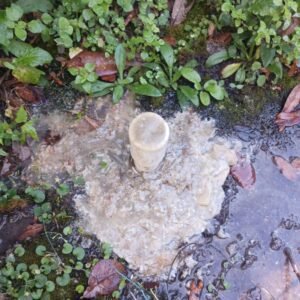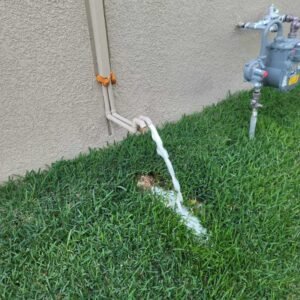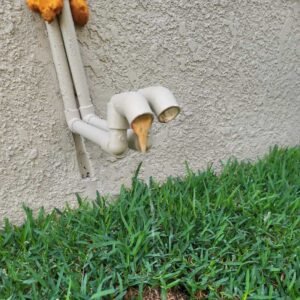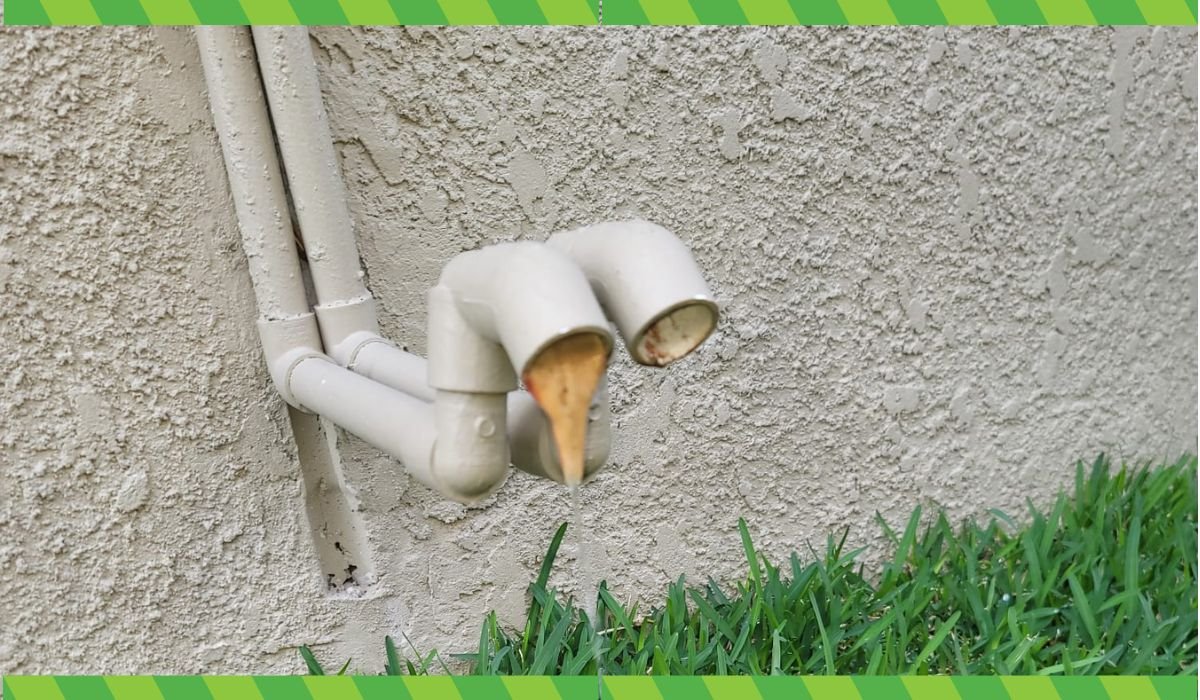How to unclog your AC’s drain line
Air conditioning units are an essential part of most homes and businesses, providing comfortable temperatures and improved air quality.
One of the most common issues faced by AC owners is a clogged drain line, which can lead to water leakage and potential damage to your property. If not addressed promptly, a clogged drain line can also impact your AC’s efficiency and lifespan.
In this blog post, we will provide a detailed, step-by-step guide to help you unclog your AC’s drain line and keep it running smoothly.
A Step-by-Step Guide to Unclogging Your AC’s Drain Line
Tools and Materials You Will Need:
- Wet/dry vacuum
- Screwdriver
- Garden hose
- Funnel
- Duct tape or plumber’s tape
- White vinegar
- Protective gloves and goggles
Safety First:
Before you begin, remember to turn off your air conditioning unit at the thermostat and disconnect the power supply to ensure your safety during the process. It’s also a good idea to wear protective gloves and goggles to safeguard yourself against any debris or bacteria in the drain line.
Step 1: Locate the Drain Line
Your AC’s drain line is usually a PVC pipe that is connected to your indoor air handler unit. It typically exits your home near the condenser unit outside.
The drain line is responsible for carrying away the condensation produced by your AC as it cools your home.
Once you’ve located the drain line, proceed to the next step.
Step 2: Inspect the Drain Line
Before you start working on the drain line, inspect it for any visible signs of blockage, cracks, or leaks.
If you spot any severe damage, try to replace the PVC pipe or contact a professional HVAC technician to address the issue.
Step 3: Remove the Drain Line Cap
At the end of the drain line, you’ll find a cap or plug that can be unscrewed or pulled off.
Carefully remove the cap to gain access to the line.
Step 4: Use a Wet/Dry Vacuum
Attach the hose of your wet/dry vacuum to the open end of the drain line, ensuring a secure seal. Use duct tape or plumber’s tape if necessary.
Turn on the vacuum and let it run for a few minutes. The vacuum should help remove any debris or build-up in the drain line, clearing the clog.
Step 5: Flush the Line with Water
Once you’ve used the vacuum, it’s time to flush the drain line with water. Connect a garden hose to a nearby water source and insert the other end into the drain line, inside your home so the water flows out.
Turn on the water and let it run for a few minutes to remove any remaining debris.
Be cautious not to use excessive water pressure, as this could damage the drain line.

Step 6: Clean the Drain Line with Vinegar
After flushing the line with water, use a funnel to pour a mixture of equal parts white vinegar and warm water into the drain line.
The vinegar solution will help break down any remaining build-up, kill mold and mildew, and prevent future clogs.
Allow the solution to sit in the drain line for about 30 minutes.
Step 7: Reattach the Drain Line Cap
Once the drain line is clear, reattach the cap or plug, ensuring a secure fit.
Step 8: Test Your AC Unit
Now that you’ve cleared the drain line, it’s time to test your AC unit.
Turn the power back on and set the thermostat to your desired temperature.
Allow the unit to run for a while, and monitor the drain line to ensure water is flowing freely and there are no visible leaks.
Step 9: Preventative Maintenance
To avoid future clogs in your AC’s drain line, consider implementing the following preventative maintenance measures:
- Schedule regular HVAC maintenance: Have a professional technician inspect and service your air conditioning unit at least once a year. They can identify potential issues before they become significant problems.
- Install a drain line safety switch: A safety switch can shut off your AC unit if the drain line becomes clogged, preventing water damage and alerting you to the issue.
- Regularly clean your AC’s drain line: Every three to six months, pour a mixture of white vinegar and warm water into the drain line to help prevent build-up and keep it clear.
- Check and replace air filters: A dirty air filter can cause your AC to work harder, leading to increased condensation and a higher likelihood of clogs. Replace or clean your air filters regularly, according to the manufacturer’s recommendations.
- Inspect the drain line for proper installation: Ensure that the drain line is installed correctly, with a proper slope to facilitate water flow and prevent standing water that could lead to clogs or mold growth.

Why do AC’s drain line get clogged?
AC drain lines get clogged due to various factors that lead to the accumulation of debris and organic matter within the pipe. The primary function of the drain line is to carry away the condensate produced by the AC system as it cools your home. The moist environment within the drain line can contribute to several issues that cause clogs. Some of the main reasons AC drain lines get clogged include:
- Condensate build-up: As your air conditioner operates, it extracts moisture from the air, which collects as condensate. This condensate is channeled to the drain line and eventually flows outside your home. Over time, the water can collect dust, dirt, and other particles that can build up in the drain line and cause a blockage.
- Mold and mildew growth: The moist, dark environment inside the drain line provides an ideal breeding ground for mold, mildew, and algae. These organisms can grow and multiply, eventually clogging the drain line and restricting the flow of water.
- Dust and dirt accumulation: Dust and dirt particles from the air can accumulate in the drain line over time. These particles can mix with the condensate and create a sludge-like substance that can lead to clogs.
- Air filter issues: If your AC’s air filter is dirty or clogged, it can reduce the airflow through your system, leading to increased condensation and a higher likelihood of clogs. A dirty filter also allows more dust and debris to enter the system, which can contribute to drain line blockages.
- Insects and pests: In some cases, insects or small pests may find their way into the drain line and create a blockage. They may be attracted to the moisture or the warmth of the AC unit.
- Improper installation: If the drain line is not installed correctly, it can lead to issues with water flow and drainage. For example, a drain line without a proper slope can result in standing water, which can contribute to clogs and mold growth.
Regular maintenance, including cleaning the drain line and changing air filters, can help prevent clogs in your AC drain line and keep your air conditioning system running efficiently.
How do you know if your ac drain line is clogged?
A clogged AC drain line can cause several issues, and identifying the signs early can help prevent damage to your air conditioning system or property. Here are some common signs that your AC drain line may be clogged:
- Water leakage: If you notice water leaking around your indoor air handler unit, it could be a sign that your AC drain line is clogged and the condensate has nowhere to go, causing it to overflow.
- Musty or moldy smell: A clogged drain line can lead to standing water in the pipe, creating an ideal environment for mold and mildew growth. If you notice a musty or moldy odor around your AC unit or vents, it could be an indication of a clogged drain line.
- Increased humidity: A properly functioning AC system helps remove moisture from the air, keeping indoor humidity levels in check. If your drain line is clogged, the system may struggle to effectively remove moisture, leading to increased humidity inside your home.
- AC system shutting off: Some AC units are equipped with a safety switch or float switch that shuts down the system when the drain line is clogged to prevent water damage. If your AC system is unexpectedly turning off, it could be due to a clogged drain line activating the safety switch.
- Visible signs of water damage: If you observe water stains or damage on your walls, ceiling, or flooring near the AC unit or the air handler, it could indicate a clogged drain line causing water to overflow.
- Reduced cooling efficiency: A clogged drain line can impede your AC’s ability to effectively cool your home, as the system may be working harder to remove excess moisture.
If you notice any of these signs, it’s essential to address the issue promptly to prevent further damage to your AC system or property. You can attempt to unclog the drain line yourself using the step-by-step guide provided above or contact a professional HVAC technician to inspect and resolve the issue.

Can a clogged drain line turn off my ac?
Yes, a clogged drain line can cause your air conditioning system to shut off. Many modern AC units are equipped with a safety feature called a float switch or condensate overflow switch. This switch is designed to detect when the condensate drain pan is full or the drain line is clogged, causing water to back up.
When the switch senses that the water level has risen above a predetermined point, it will trigger the safety mechanism and turn off your air conditioning system. This is done to prevent water damage to your property and protect the system’s components from potential damage due to overflowing water.
If your AC shuts off unexpectedly and you suspect a clogged drain line, you should address the issue promptly. You can attempt to unclog the drain line yourself following the steps provided earlier in this blog, or contact a professional HVAC technician for assistance. Once the drain line is clear and the water can flow freely, the float switch should reset, allowing your AC system to resume normal operation.
How much does it cost to unclog an ac drain line?
The cost to unclog an AC drain line can vary depending on several factors, such as your location, the complexity of the issue, and whether you choose to tackle the problem yourself or hire a professional HVAC technician.
If you decide to unclog the drain line yourself, the cost will typically be low, ranging from $10 to $50. This estimate covers the cost of basic tools and materials like a wet/dry vacuum, funnel, and white vinegar.
However, if you choose to hire a professional HVAC technician, the cost will generally be higher. On average, you can expect to pay between $180 and $220 for a service call to unclog your AC drain line. Keep in mind that prices can vary depending on factors such as regional labor costs, the severity of the clog, and whether additional services or repairs are needed.
In some cases, unclogging the AC drain line may be included as part of a regular maintenance visit. Scheduling routine maintenance for your air conditioning system can help prevent clogs and other issues, saving you money and ensuring your AC unit runs efficiently.
Where is my drain line located?
The drain line for your air conditioning system is typically connected to the indoor air handler unit. The air handler houses the evaporator coil, which generates condensation as it cools the air. The drain line’s purpose is to carry this condensate away from the unit and release it outside your home. To locate your AC drain line, follow these steps:
- Locate the air handler: The air handler is usually found in your home’s attic, basement, crawl space, or a dedicated closet. It is a large metal box that contains the blower fan and the evaporator coil.
- Identify the drain pan: Beneath the evaporator coil, you should see a drain pan designed to collect condensate that may drip from the coil. This pan is typically shallow and made of metal or plastic.
- Find the PVC pipe: The AC drain line is usually a white or gray PVC pipe (about 3/4 inch in diameter) connected to the drain pan or the evaporator coil’s housing. The pipe will extend from the air handler and run to an exit point outside your home.
- Follow the drain line to the exit point: Trace the PVC pipe as it runs through your home, often through walls or ceilings, until you find the exit point. The exit point is typically located near the outdoor condenser unit or in some cases may terminate over a window well or other visible area. The end of the drain line may have a p trap, helping the water drain more efficiently.
It’s essential to inspect and clean your AC drain line regularly to prevent clogs and potential water damage to your home. If you’re unable to locate your drain line or are unsure about how to clean it, consider contacting a professional HVAC technician for assistance.

How can I keep my drain line clear and free of clogs?
Keeping your AC drain line clear and free of clogs is essential for maintaining the efficiency and longevity of your air conditioning system. Here are some tips to help you prevent clogs and keep your drain line in good condition:
- Regular maintenance: Schedule routine HVAC maintenance with a professional technician at least once a year. They will inspect, clean, and service your air conditioning system, addressing any potential issues before they become significant problems.
- Clean the drain line: Every three to six months, pour a mixture of equal parts white vinegar and warm water into the drain line using a funnel. This solution will help break down any build-up, kill mold and mildew, and prevent future clogs. Allow the solution to sit in the drain line for about 30 minutes before flushing it with water.
- Check and replace air filters: Dirty air filters can cause your AC system to work harder, increasing condensation and raising the likelihood of clogs. Moreover, a clogged filter allows more dust and debris to enter the system, which can contribute to drain line blockages. Replace or clean your air filters regularly, according to the manufacturer’s recommendations.
- Inspect the drain line: Regularly inspect your drain line for any visible signs of blockage, cracks, or leaks. If you spot any severe damage or persistent clogs, it’s best to contact a professional HVAC technician to address the issue.
- Ensure proper installation: Make sure the drain line is installed correctly, with a proper slope to facilitate water flow and prevent standing water that could lead to clogs or mold growth.
- Install a drain line safety switch: A safety switch can shut off your AC unit if the drain line becomes clogged, preventing water damage and alerting you to the issue. This device can be a valuable addition to your AC system.
- Keep the outdoor exit point clean: Regularly check the outdoor exit point of your drain line to ensure it’s not blocked by dirt, debris, or pests. Remove any obstructions to allow water to flow freely.
By following these tips and performing regular maintenance, you can keep your AC drain line clear, free of clogs, and ensure that your air conditioning system operates efficiently.
Ensuring a Clear Drain Line and Optimal AC Performance with The AC Therapist
In conclusion, keeping your AC drain line clean and free of clogs is crucial for maintaining the efficiency, performance, and longevity of your air conditioning system. Following the tips and preventive measures outlined in this blog will not only help you avoid potential water damage but also save you money on costly repairs and energy bills. Regular maintenance, cleaning, and inspection of your air conditioning system will contribute significantly to your indoor comfort and air quality, particularly during the hot summer months.
While many of these steps can be performed by homeowners themselves, it’s essential to recognize the value of professional expertise in maintaining your AC system. That’s where The AC Therapist comes in. As a leading HVAC service provider, The AC Therapist offers top-notch maintenance, repair, and installation services for all your air conditioning needs. Our team of certified technicians is equipped with the latest tools and knowledge to keep your AC running at peak performance.
By choosing The AC Therapist for your HVAC needs, you can rest assured that your air conditioning system is in good hands. We provide comprehensive inspections, cleaning, and preventative maintenance packages to ensure your AC remains efficient and problem-free. Additionally, if you encounter any issues that require professional attention, our skilled technicians are available for prompt and reliable repair services.
Don’t wait for a clogged drain line or other AC problems to ruin your indoor comfort. Schedule an appointment with The AC Therapist today and experience the peace of mind that comes with knowing your air conditioning system is well-maintained and ready to keep you cool all summer long. Visit our website or give us a call to learn more about our services and how we can help you maintain a healthy, efficient, and reliable air conditioning system.








